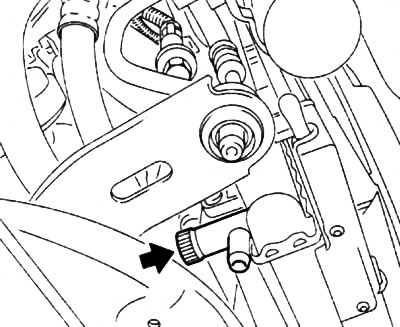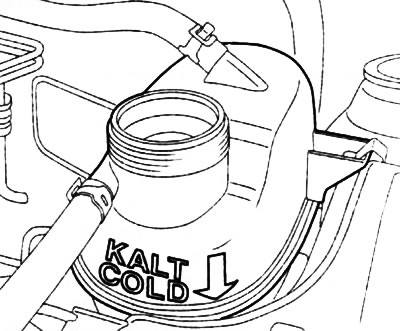2. During maintenance, the condition of all hoses in the system must also be checked (see chapter 1). Defective components must be replaced (see Section 4).
3. Do not forget about the precautions that must be observed when servicing the cooling system (see section 2). The direct execution of maintenance procedures should be started only after the engine has completely cooled down, i.e. a few hours after the end of the trip.
Caution: Make sure that no coolant gets on the toothed belt or multi-ribbed belt when working with coolant! The glycol in the coolant can damage the toothed belt fabric to such an extent that the belt breaks after some time of operation, which in turn can lead to severe engine damage!
Emptying
4. Remove the expansion tank filler cap. Caution: If the engine is not yet completely cool, wrap the cap with a cloth to eliminate the risk of scalding (see Chapter 1, Section 4)!
5. If necessary, raise and place the car on stands, remove the engine crankcase protection, (see Chapter 2, Section 5).
6. Place a clean container of the appropriate size under the radiator. For the convenience of draining the coolant, it is recommended to put on the drain pipe (see resist. illustration) lower the hose and its other end into the prepared container.

3.6. drain valve (indicated by an arrow) cooling systems
7. Open the drain valve on the radiator and drain the fluid.
8. Close the valve and lower the car.
Refueling
9. Check up serviceability of a condition and reliability of fastening of all hoses of a cooling path. Replace defective components, tighten clamps (see Section 4).
10. Fill the coolant into the expansion tank up to the marking level «KALT/COLD» (see resist. illustration) on the translucent wall of the tank.

3.10. Expansion tank
11. Reinstall the expansion tank cap.
12. Start the engine and let it warm up to normal operating temperature until the thermostat valve opens (lower radiator hose should get hot). Air from the cooling system during engine warm-up
13. On Z13DT/Z16XE/Z18XE engines, increase the speed to 2500 rpm so that the first stage of the fan turns on. After turning off the fan, let the engine run for about 2 minutes at 2500-3000 rpm - during this time the air from the cooling system will be completely removed through the hoses of the expansion tank.
14. Inspect the cooling system components for signs of leaks, then stop the engine and allow it to cool completely.
15. If equipped, install the crankcase protection.
16. Finally, check the coolant level again and correct if necessary (see chapter 1). Tighten the expansion tank cap.

Visitor comments